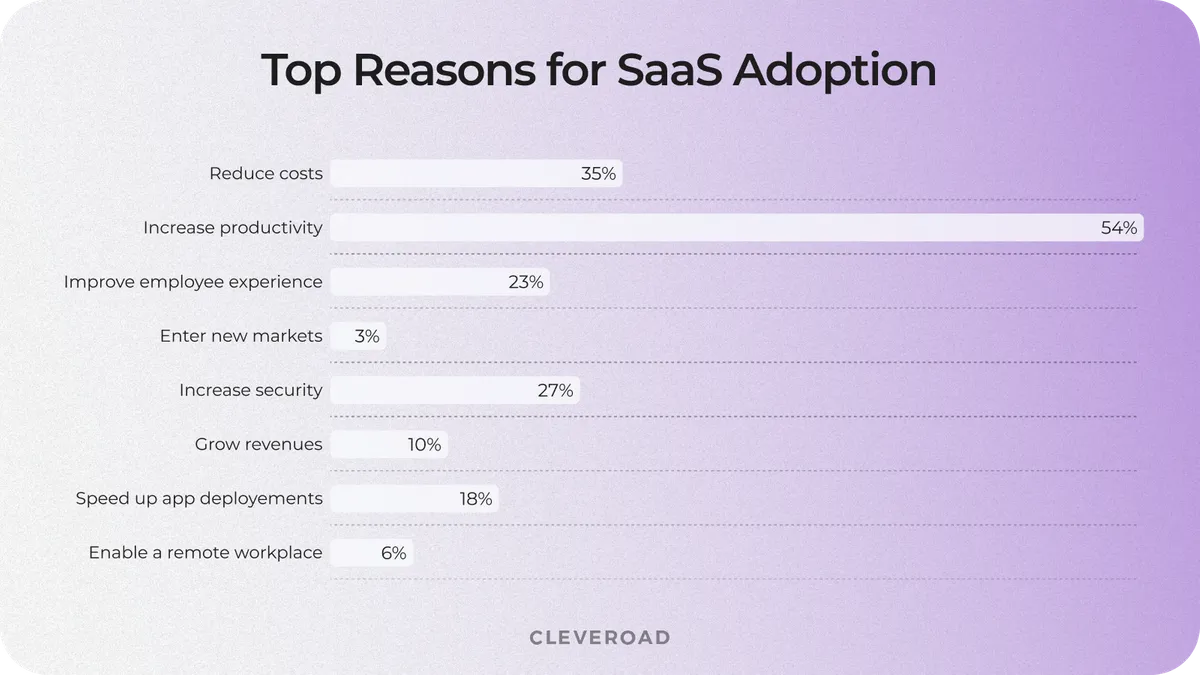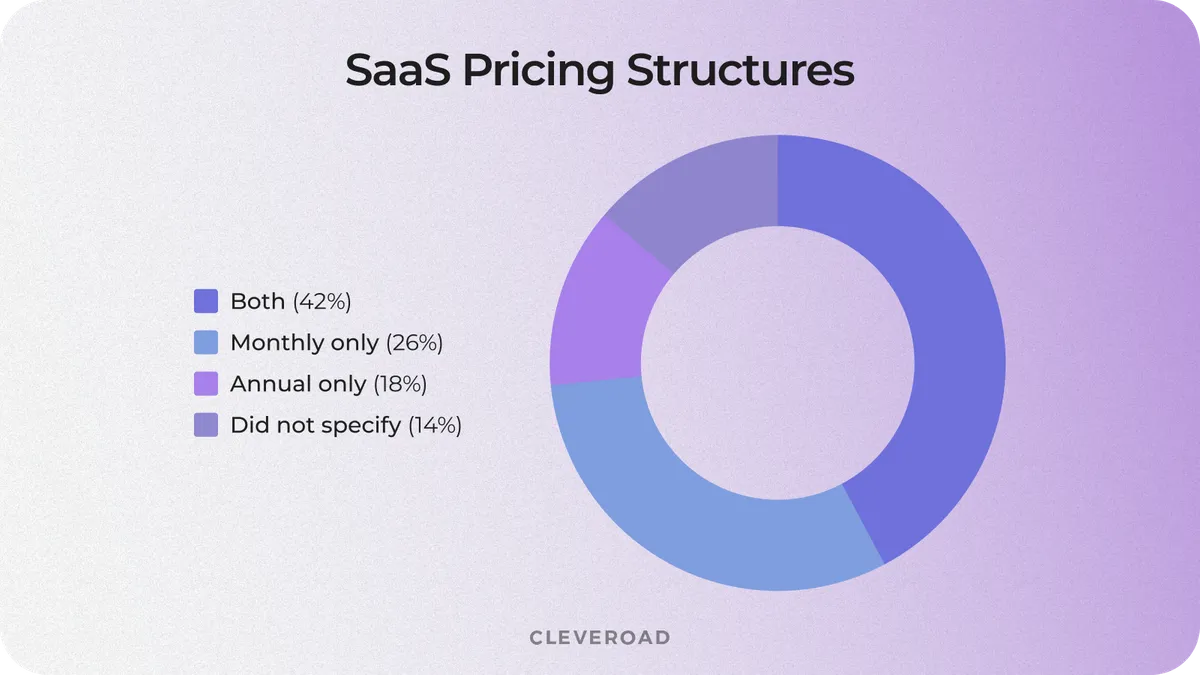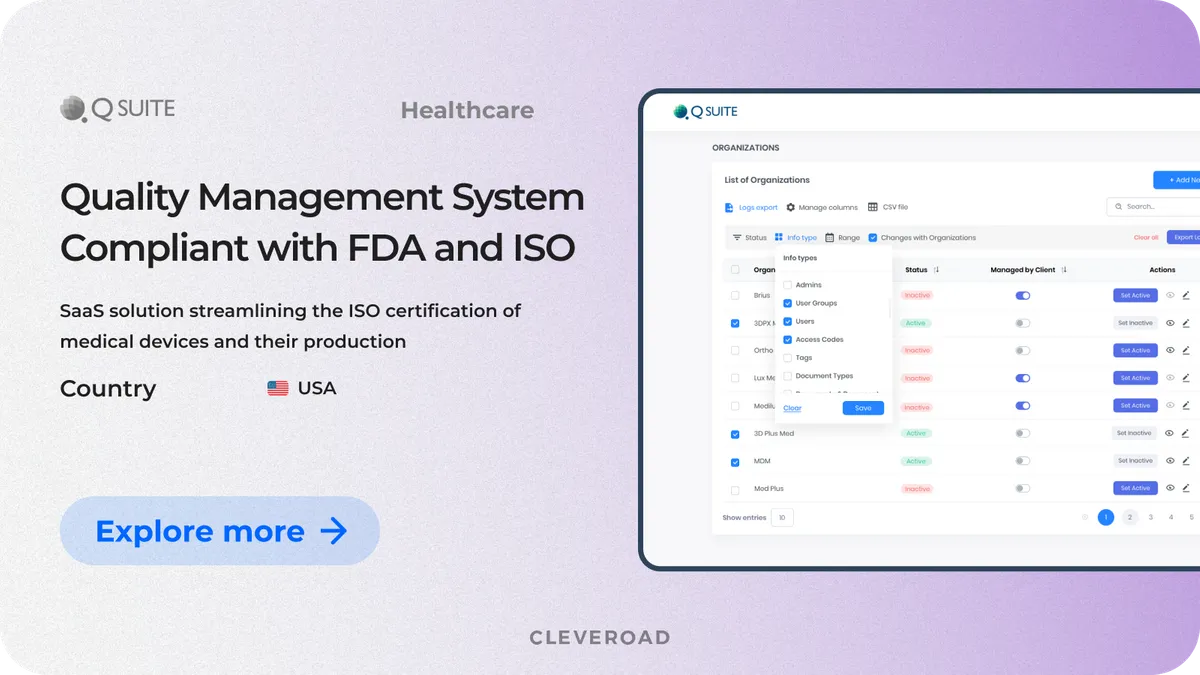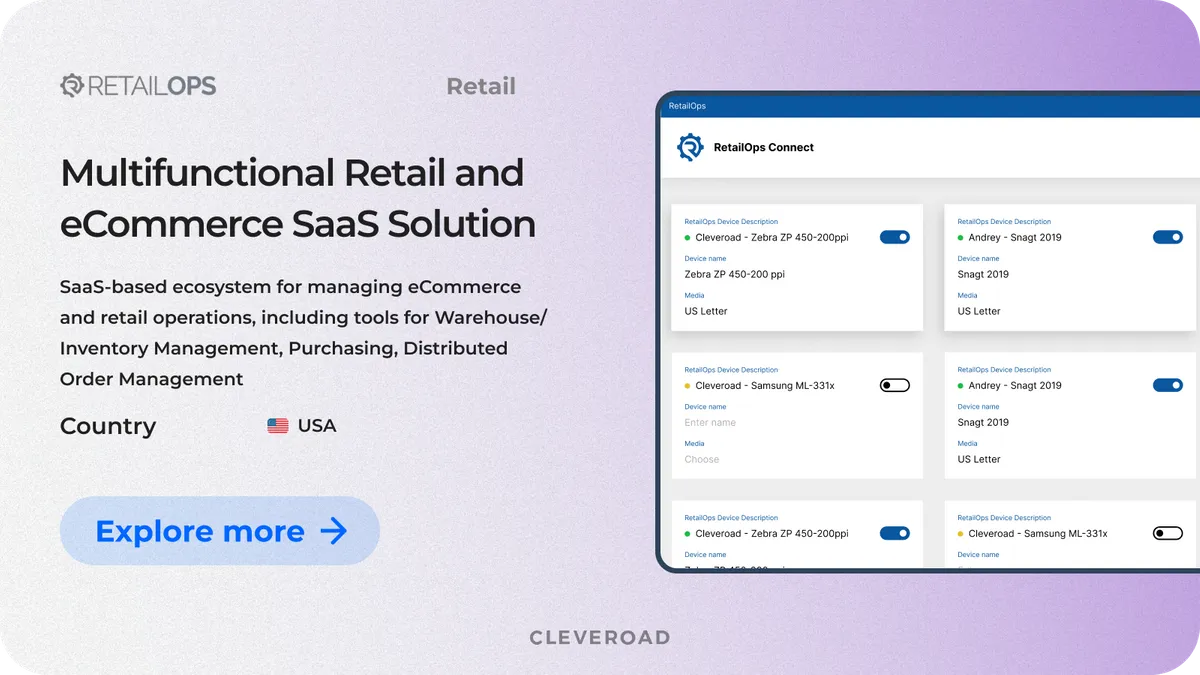How to Build Software as a Service: Benefits, Use Cases, Implementation Strategy
Updated 18 Jun 2025
15 Min
521 Views
How to build a SaaS product, and why it may be the best decision you’ll make for your business? Let’s say you run a business and already know that off-the-shelf tools lack the features, flexibility, or integration you need. That’s the moment you realize a custom SaaS solution may come in handy. You build it once, host it in the cloud, and sell access on a subscription basis. Customers pay monthly or yearly, while you keep full control over pricing, features, and growth.
At Cleveroad, we helped many businesses to enhance efficiency and boost revenues by creating custom SaaS solutions. As an IT vendor with over 13 years of experience in software development, we’ll guide you through the key stages of building a successful SaaS product, provide a clear development roadmap, and help you understand and manage potential costs.
What Is a SaaS Product and How Does it Work?
A Software as a Service (SaaS) product is software that runs entirely online, with no installation or maintenance required by the user. Basically, you just log in and start working, like you do with popular SaaS apps like Slack, Zoom, or Google Docs. Everything is hosted in the cloud, updated automatically, and built to scale as your user base grows. You control updates, features, and billing from one place, while users enjoy a seamless and up-to-date experience. If you're aiming for recurring revenue and a broad, scalable reach, SaaS is one of the smartest product models to build today.
How does SaaS work?
To give you a clearer picture of how SaaS products actually work, here’s a simple breakdown of the core principles behind the model:
- You host the software in the cloud. No local installation needed, everything runs on your servers or a cloud provider like AWS or Azure.
- Users access it via the internet. Your users log in through a browser or app from anywhere, on any device with no need of installation.
- You offer it as a subscription. Users pay monthly or annually for access, as different plans unlock different features or limits.
- You handle updates and maintenance. All patches, improvements, and fixes happen on your side; users always get the latest version.
- You scale the product as demand grows. Add more users, features, or integrations without changing how users access the tool.
Benefits of Building a SaaS Product
To understand SaaS actual impact, let’s take a closer look at what exactly makes SaaS products stand out from traditional software solutions.
Quick deployment
The faster you build a SaaS platform, the sooner users can start using it and providing valuable feedback. Quick deployment speeds up validating your idea, helps you start earning revenue earlier, and can give you a head start over competitors. Unlike traditional software, SaaS lets you move quickly from concept to market without long delays.
Lower cost
The majority of businesses decide to build a SaaS solution because of its cost efficiency. For sure, SaaS development eliminates the need for upfront investments, expensive hardware, staffing, and operational costs like security or infrastructure management.
Apart from this, the SaaS development approach brings clarity into your budget planning by providing predictable monthly or annual fees. Also, SaaS providers typically offer transparent fees that let you avoid unexpected charges and occurrences. Lower costs is generally one of the primary reasons for SaaS adoption.
Below you can examine a comprehensive graph representing key reasons for SaaS adoption:

Main reasons for SaaS adoption. Source: Enterprise App Today
Compatibility potential
SaaS software is also convenient in terms of user experience. Your users can employ a single application with a responsive design that is interoperable on smartphones, tablets, laptops, etc. In essence, everything that is needed for a SaaS app's accurate performance is a stable internet connection.
Advanced scalability
Understanding how to build SaaS product that scales means leveraging cloud infrastructure. Extended scalability options let your solution easily handle more users and growing data volumes as your business expands. Plus, with API integrations, you can tailor your SaaS product to fit your unique business needs without hassle. Typically, these integrations include:
- CRM systems (e.g., Salesforce, HubSpot)
- Payment gateways (e.g., Stripe, PayPal)
- Marketing platforms (e.g., Mailchimp, Marketo)
- Analytics tools (e.g., Google Analytics, Mixpanel)
- Communication apps (e.g., Slack, Zoom)
- Cloud storage services (e.g., AWS S3, Google Drive)
You can utilize our cloud app development services to create a SaaS product that will bring you all these benefits
6 Steps to Build a SaaS Product
Cleveroad's AWS-certified Solution Architect helped us to put together a clear and practical 6-step guide to SaaS product development. Let’s explore each stage in detail.
Step 1. Define SaaS implementation goals
Start by clearly outlining what you want to achieve with your SaaS product. Define your target users, including their needs, behaviors, and pain points. Pinpoint your core business objectives, whether it’s increasing revenue, improving customer experience, or streamlining operations. Also, identify the specific problems your solution will address and how it will deliver value. Keep in mind that a clear foundation shapes every SaaS design and development decision, aligns your team, and provides measurable criteria to evaluate success once your product is released.
Step 2. Find a credible SaaS development partner
Choosing the right SaaS building partner is critical, as the overall success of your product heavily depends on the development team’s expertise and alignment with your product concept. A reliable partner should have strong technical skills, like expertise in cloud architecture, data security, and API development. Also search for experience in developing SaaS products for your specific domain, be it healthcare, finance, logistics, or another niche. Look for vendors who’ve delivered similar projects, can demonstrate a clear product concept understanding, and have a portfolio with measurable results. It's also important that the team understands your business model, user base, and growth goals, to ensure the SaaS products offer real value and align with your strategic direction.
Start your search by exploring trusted vendor directories such as Clutch, GoodFirms, or ITFirms, where you can filter companies by expertise, location, and client ratings. Pay close attention to past client reviews and testimonials, as they reveal the vendor’s ability to meet deadlines, communicate clearly, and solve unexpected challenges.
Need a proficient SaaS development partner?
Let us help you. Cleveroad’s SaaS experts will guide you in creating reliable, scalable, and profitable SaaS solutions that precisely address your business needs and are built to succeed in the market
Step 3. Determine key SaaS project requirements
Once you’ve chosen a development partner, the next step is to collaboratively define your SaaS product’s technical and functional requirements. At Cleveroad we do this through our structured Solution Workshop and Discovery Phase. During workshops, our solution team, including business analysts, solution architects, and designers digs into your business needs, challenges, and goals to shape a vision aligned with your product concept. You receive this service for free.
During the Discovery Phase, we clarify the functional scope, third-party integrations (like payment gateways or CRMs), platforms, and compliance needs. Our experts define architectural preferences (monolith or microservices), security measures, and quality attributes. These insights are documented in deliverables like a high-level feature list, UX maps, and a detailed Software Architecture Document (SAD).
By the end of this process, you receive a comprehensive development proposal with timelines, team composition, cost estimates, and tech stack recommendations, laying a solid foundation to build your SaaS with clarity and confidence.
We at Cleveroad have AWS Select Partner status, guaranteeing faster, secure, and scalable SaaS development with lower costs and less infrastructure hassle
Step 4. Choose a SaaS monetization model
You can build a flawless SaaS application, but sure enough, you won’t be very delighted if it won’t bring you profit. To ensure smooth revenue generation, setting a suitable monetization strategy is important. There are six of the most utilized monetization methods you can adhere to in your solution:
- Freemium model. Users get limited features for free and can pay to unlock more advanced functionality as their needs grow.
- Pay-as-you-go model. Users are charged based on actual usage, which is suitable for variable workloads or seasonal demand.
- Flat rate pricing model. A single monthly or yearly fee gives full access to all features, regardless of usage volume.
- Per-user model. Companies pay a fixed cost per user account, scaling pricing as operational usage and team size grows.
- Per-active-user model. Charges apply only to users who actively use the service within a billing cycle (e.g., monthly).
- Tiered pricing model. Different plans offer various features, limits, or support levels to match user needs and budget.
Besides the monetization model, you’ll need to decide how often users will be billed for your SaaS solution (e.g., monthly, annually, or offering both options). This defines your revenue flow and affects user retention, cash forecasting, and overall customer lifetime value.
Below is a visualization showing the percentage of businesses using each billing strategy:

SaaS pricing structures usage rate. Source: Enterprise App Today
Based on the diagram, the most effective SaaS pricing strategy is a hybrid model combining tiered pricing and usage-based billing. This approach supports scalable SaaS growth, aligns cost with value, making it ideal if you’re a startup or even a mature SaaS business.
Step 5. Develop your SaaS product
At this stage, you and your development team work on transforming your SaaS vision into a working system. Our engineers set up the full architecture, like building a secure and scalable backend (typically using Node.js, Python, or .NET), and designing a responsive frontend (with React, Angular, or Vue.js). The infrastructure is deployed on reliable cloud platforms like AWS, enabling auto-scaling, CI/CD pipelines, and high availability.
We ensure smooth integration of third-party services like payment gateways, analytics, CRMs, or custom APIs. Besides, our QA team runs unit, integration, and regression tests in parallel to minimize bugs and shorten feedback loops. If you are wondering how to create software as a service, this phase is critical in building a SaaS platform that meets your goals and user expectations.
Step 6. Test, launch, and monitor your SaaS solution
Before going live, we run comprehensive testing: functional (to check all features), performance (to ensure speed under load), security (to guard against threats like XSS, CSRF, or data leaks), and user acceptance testing (UAT) to ensure everything aligns with your expectations. We simulate real-world usage scenarios to detect any bottlenecks or edge-case failures.
Once deployed, we help you launch smoothly by setting up monitoring tools (like AWS CloudWatch, Sentry, or Datadog), automating backups, and ensuring zero-downtime updates. Our DevOps team manages scaling, load balancing, and database optimization as your active users grow. Post-launch, we stay involved to resolve issues, iterate on user feedback, and help you release new features confidently. This continuous involvement ensures you’re not just creating a SaaS, but building a long-term, evolving product ready for real market demands.
Get to know more about SaaS application development regarding key pitfalls to be aware of, cost, and more in our guide
Short-Story Cases on How Cleveroad Successfully Built and Delivered SaaS Products
We want to present you with some examples of SaaS projects our team successfully made and delivered for different business domains.
Quality Management System for medical devices manufacturers
Our US-based customer – Prime Path Medtech, reached out to us to replace their current Quickbase-based QMS solution, which lacked flexibility and didn’t fit into the B2B business model.
We’ve decided to completely remove the Quickbase and replace it with an automated QMS that appears more efficient within the B2B SaaS business model and complies with 21 CFR 820 and 21 CFR 11 and the ISO 13485 requirements. Our next goal was to enrich the QMS with a customer’s quality control services while keeping essential roles, functions, and processes for medical device certification. Apart from this, we needed to boost the customer's revenue level and user satisfaction rate while adhering to particular budget limitations.
As a result, the customer received a responsive SaaS web-based QMS that obtained a more engaging user experience and more flexible and convenient functionality. Being organically integrated, our QMS enabled the customer to significantly reduce costs due to the lower price of B2B SaaS usage.
Here’s what Breanne Butler, Client Liaison Officer at Prime Path Medtech™ says about collaboration:
Breanne Butler, Client Liaison Officer at Prime Path Medtech™ provides feedback about collaboration with Cleveroad
Powerful SaaS retail operation platform
The RetailOps is a SaaS platform for various retail operations, from warehouse management to Inventory receiving and control. The company reached out to us to redesign the current solution to make it more appealing and enhance its functional capabilities, making the app easier to use.
The final solution included re-constructing an application infrastructure by switching from Cordova to Swift, which is native for iOS development. Moreover, our software engineers integrated the Socket Mobile barcode scanner engaging its SDK, which allows iPhones to connect with it via Bluetooth.
As a result, the customer received a multifunctional Retail and eCommerce SaaS product, ensuring an optimized ability for inventory tracking, minimizing its damage and losses, and obtaining more sustainable revenue.
Below you’ll find a comprehensive feedback from RetailOps’ CTO, Daniel Norman:


SaaS Product Development Trends
SaaS product development is a major trend on its own, but there are also deeper, more innovative shifts shaping the landscape. Here are 3 key trends to watch during SaaS building:
No-code and low-code tools
Low-code and no-code platforms let you start building and test ideas quickly, even if you're not a developer. You can launch features, tweak designs, and get real feedback without spending weeks writing code. It’s a major benefits of SaaS development approach that lowers the barrier for many software companies and online retailers alike. These tools help you build something fast, supporting milestones for SaaS application development and software updates with less cost and more flexibility. Whether you’re entering the SaaS industry or looking to start your SaaS, no-code accelerates the product development roadmap and helps create a SaaS product that resonates with users.
AI personalization
AI provides completely new solutions for SaaS by enabling dynamic personalization at scale. AI-driven systems adapt based on user behavior, delivering intelligent recommendations and automated workflows that boost engagement and retention. Software development specialists and software products that incorporate AI help businesses uncover the latest SaaS trends, creating smarter tools aligned with user needs. If you’re working on CRM, support, or analytics platforms, AI helps you build your saas to deliver contextual experiences and scale effectively. This makes SaaS ideal for startups and mature software licenses holders alike.
We provide a wide range of AI development services you can utilize to create an innovative SaaS solution with scalability in mind
API-first development approach
An API-first mindset means your SaaS product is built to easily connect with other apps and systems from the start. This flexibility is critical for SaaS products often used in complex environments, enabling seamless integration with enterprise software and other software infrastructure. When you develop a SaaS product this way, it’s easier to scale and customize to evolving objectives for the SaaS application and a growing user base without disruption. This approach is favored by many SaaS vendors because it ensures your product fits into the broader ecosystem, making it easier to migrate your web application or extend its capabilities.
How Much Does It Cost to Create a SaaS Solution?
The price to develop Software as a Service product is genuinely rooted in the development timeline and the development specialists’ rates. The time to develop a comprehensive SaaS solution depends on feature complexity, the number of integrations, the tech stack, UI/UX design, the SaaS type, the cooperation model, etc.
The number of factors that should be included makes it quite challenging to provide a detailed SaaS development cost. Primarily, your IT partner needs to become familiar with your requirements list, and only then can they provide you with an orientation on the pricing. However, taking all these factors into account, it’s considered that SaaS development cost ranges from $50,000 to $300,000+.
Here are the two most widespread options to optimize the cost:
- Minimal Viable Product (MVP). Starting from MVP development services gives you a chance to focus on core functionality, avoiding excessive features in the beginning. This approach can show you the market response to your solution with minimal investment. Besides, MVP facilitates time-to-market, allowing you to generate revenue sooner.
- Outsourcing. Outsourcing SaaS building allows you to access unique expertise worldwide, offering you various quality and cost options. Hiring globally, you can find developers that will be a perfect fit for your demands and budget. Outsourcing can significantly cut labor expenses, as an outsourcing team costs less than forming an in-house team. This approach is highly scalable, which means you can scale resources, minimizing the need for permanent costs.
While outsourcing SaaS development, keep in mind that the pricing may range depending on up-to-date outsourcing software development rates. You can examine SaaS development rates based on type of service in popular outsourcing regions below:
| Type of service | Western Europe | Central and Eastern Europe | Asia | North America | South America | Africa |
Project Manager | $59-$177 | $25-$50 | $25-$80 | $80-$150 | $30-$70 | $20-$60 |
Business Analyst | $47-$141 | $20-$40 | $20-$60 | $70-$130 | $25-$60 | $15-$50 |
Solution Architect | $82-$212 | $30-$60 | $40-$100 | $90-$160 | $40-$90 | $30-$70 |
UI/UX designer | $47-$141 | $20-$50 | $20-$60 | $70-$130 | $25-$60 | $20-$50 |
Front-end developer | $47-$141 | $20-$50 | $15-$50 | $70-$140 | $20-$50 | $15-$50 |
Back-end developer | $50-$150 | $25-$60 | $15-$50 | $80-$150 | $25-$60 | $20-$60 |
DevOps | $59-$177 | $25-$50 | $20-$60 | $80-$150 | $30-$70 | $20-$60 |
QA engineer | $47-$141 | $20-$40 | $15-$50 | $70-$130 | $20-$50 | $15-$40 |
Cleveroad – Your Reliable SaaS Development Partner
Cleveroad is an outsourcing software development company headquartered in Estonia with over 13+ years of experience in IT. Our expertise includes the development of custom digital solutions for various business domains: Logistics, Healthcare, Retail, FinTech, E-Commerce, Education, etc.
Cooperating with us may bring you considerable benefits, including:
- We tailor SaaS product development to your business model, whether B2B, B2C, or multi-tenant, ensuring architecture, stack, and flows match your long-term goals.
- We implement AI tools for automation, user analytics, and personalization to help your SaaS adapt intelligently to evolving customer needs.
- Cooperation with AWS-certified software engineers with practical expertise in building and deploying SaaS applications
- A reliable and highly skilled team with proven experience in dealing with cloud services, such as AWS, Azure, Google Cloud
- Flexible cooperation models to select from, to align with your timeline and budget, icnluding Dedicated Team, Time & Material, Staff Augmentation
- A hands-on experience in delivering software solutions across various domains, including FitTech, Healthcare, Retails, Logistics, etc.
- Continuous quality assurance and precise monitoring at every development stage
The Cleveroad’s team is equipped to transform your SaaS application concept into a robust and attractive solution meeting your domain business requirements and unique vision.
Build a profitable SaaS solution now
Our SaaS experts with over 13 years of experience in cloud software delivery will assess your needs and build a scalable solution to streamline your workflows and open up new revenue streams
A SaaS (Software as a Service) product is a cloud-based product description users interact with online. Instead of installing programs locally, they access the software through a browser. This approach allows seamless software usage and removes the burden of updates and infrastructure. A SaaS model offers automatic scalability, central management, and rapid deployment. Whether it's a product like a CRM or a project tracker, users benefit from consistent improvements without the need for manual updates. This makes SaaS ideal for businesses aiming to deliver reliable software applications through an efficient SaaS platform development process.
To develop a SaaS product from scratch, start by validating your product idea. Conduct market research to validate your product, then define your core product feature set and tech stack. Whether you're building a product for internal use or for launch in the SaaS market, having a detailed product roadmap is key. Collaborate with a strong SaaS development team and experienced SaaS developers to design, build, and test. Include key elements like a secure SaaS app’s server side, and use cloud-based CI/CD pipelines. A minimum viable product is then launched to test real-world traction before full-scale product launch and iteration.
A typical SaaS roadmap includes six main phases:
- Define your product description, target market, and key product feature.
- Design UX/UI, set a tech stack, and prepare for SaaS software development.
- Create infrastructure, develop the backend and frontend, and built a SaaS app.
- Launch your minimum viable product, gather user feedback, and improve.
- Integrate tools to ensure users can access the application easily.
- Use analytics to make informed decisions, scale, and maintain security.
SaaS pricing depends on the complexity, team structure, and features required to build your product. Working with experienced SaaS companies ensures you cover typical challenges in SaaS like scaling, compliance, or third-party integration. Whether you want to build your SaaS from a web application to SaaS or start from scratch, you’ll need experts to guide you and help you make informed decisions. Costs typically range from $50,000 to $300,000+. From vertical SaaS tools to general-purpose platforms, the more complex your building a product is, the higher the investment.

Evgeniy Altynpara is a CTO and member of the Forbes Councils’ community of tech professionals. He is an expert in software development and technological entrepreneurship and has 10+years of experience in digital transformation consulting in Healthcare, FinTech, Supply Chain and Logistics
Give us your impressions about this article
Give us your impressions about this article

